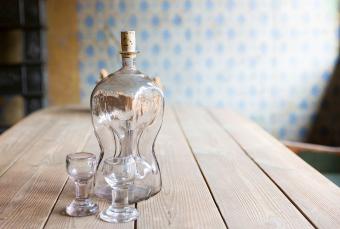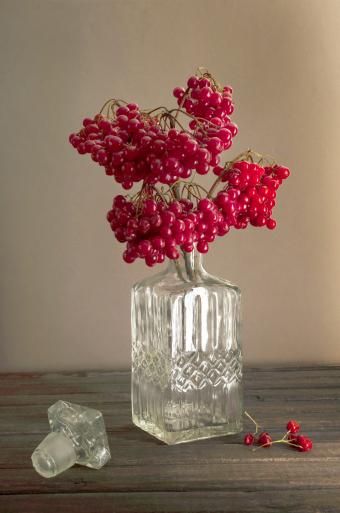Antique Glass Decanters That'll Upgrade Any Kitchen

One of the first things you'll probably notice when you step inside of an antiques store is the overwhelming amount of glassware that's taking up row after row of the store's shelves. It's so easy to let their swirling patterns and rich pigments distract you, but falling prey to the pretty sights can cause you to miss out on many of the store's hidden gems, like the elongated antique glass decanter hidden in a back corner. Popular for centuries, these serving tools continue to be such a fashionable collectible that they always look at home right out of the bag.
What's a Decanter Used For?

Decanters have been around since antiquity, with Ancient Roman artisans pioneering the use of glass instead of metal in their creation. These designated containers were used to transport beverages like wine and spirits that could have lingering sediments in their mixture. Decanting liquids also gives them room to breathe and enhance their aromas and flavors. Wine and some spirits continue to be decanted to this day.
How to Pick out an Antique Decanter in the Wild

Depending on the era they were created in, antique decanters can either be super easy to pick out or unassuming enough to be passed over by the untrained eye. For instance, it wasn't until the early 18th century that decanters began to be accompanied by stoppers, which were used to limit the amount of exposure the decantations had to the air. Similarly, bottle shapes, colors, and decorative elements frequently changed with passing fashions over the years, meaning that there's a whole plethora of decanters to familiarize yourself with.
Common Antique Decanter Characteristics

From Ancient Roman to Italian to American and spanning the length of time and space, there's a rainbow of antique decanters to choose from. Of course, wine enthusiasts and collectors have their favorite types, but there're some general characteristics that you can look out for that'll help you determine an antique decanter from a modern one:
- Imperfections in the glass - Despite their delicate appearances and lofty associations, antique glass decanters often have imperfections like bubbling trapped inside the glass layers.
- The presence of pontil scars - Pontil marks occur when the pontil rod that glassblowers use to inflate the glass with air is broken off of the glass piece. These cylindrical scars are particularly common for older antiques that were created long before industrial advancements and mold making commodified the process. They are found at the bottom of the decanter.
- Distinctive Shapes - Antique glass decanters were usually created with elongated necks and large bodies, with later styles including matching stoppers.
Taste the Rainbow of Decanter Colors

Another important stylistic factor is the brilliant array of colors. While this does challenge the popular image of the crystal clear decanter perched atop a silver tray on a bar cart, it makes for an appealing collectible to people with all sorts of differing tastes. Some of the colors you can find these older decanters made out of include:
- Blue
- Purple
- Pink
- Red
- Green
Glass Decanter Shapes to Dazzle Your Guests With

Another perk of picking up an antique glass decanter in lieu of a modern one is the myriad of shapes at your disposal. Whether you prefer them thin and slender or short and heavily decorated, there's an old decanter out there for you. A few of the more usual shapes you might come across include:
- Circular
- Triangular
- Rectangular
- Tear-drop
Easy Tips for Dating Antique Decanters

Given that many glass decanters are devoid of maker's marks and other identifying clues, it can feel like you're taking a shot in the dark when you're trying to date one. Unlike some antiques with definite markers, the easiest way to give yourself an approximate date for glass decanters is based on their designs. Three of the most common styles of historic glass decanters you can find currently on the market are Victorian, Art Nouveau, and Art Deco.
Victorian Glass Decanters

Out of all three of these aesthetics, Victorian glass decanters are the most typically 'antique' looking. They were usually made out of clear lead glass and featured a lot of intricate design elements such as engravings and cane work, which created visual intrigue in their multifaceted displays.
Art Nouveau Glass Decanters

Decanters made during the Art Nouveau period were delightfully strange, with artisans bending the glass to their will and creating shapes the likes of which the world hadn't yet seen. These decanters were colorful and featured a lot of imagery from the natural world like vines and birds, with makers like Louis Comfort Tiffany leading the charge.
Art Deco Glass Decanters

Considering that Art Deco design was focused on geometric shapes and severe lines, it's unsurprising that decanters made during this period would be similarly sleek in their construction. Decanters of this period tended to be made out of clear glass, though they were occasionally crafted out of colored glass and topped with silver accents, with their shapes focusing on vertical or horizontal height and noticeable geometric forms.
Sign up for our newsletter featuring all the latest stories and products we love.
What Makes Antique Decanters Valuable?

Thanks to their delicate and beautiful appearances, certain types of glass decanters can rack up impressive amounts of money at auction. Typically, the finest lead glass (also known as cut crystal) with intricate designs and an elongated stem and stopper are the easiest types of decanters to sell, ranging in price from the low hundreds to the low thousands. Take, for instance, this cut crystal decanter from the early 20th century that recently sold for $2,215.
Art Deco Decanters at Market

Additionally, there's been a resurgence in fondness not only for vintage decanters but also for the streamlined cut crystal made during the Art Deco period. With their strong lines and austere forms, they match modern industrial design incredibly well. Similarly, they tend to look less stereotypically 'old,' which is something a lot of non-collectors gravitate towards. For example, you could easily find this beautiful skyscraper styler cut crystal decanter from around 1930 sitting on the shelf at a home goods store today.
Nonalcoholic Alternatives to Put Your Decanters to Use

Although decanters are made to house and serve alcoholic beverages, people who don't imbibe alcohol can still enjoy them. Don't let these fancy pieces of serving ware collect dust; instead, try out one of these cool alternatives:
- Turn it into a vase - Depending on what size decanter you have, you can convert it into a highly decorative vase to hold your favorite cut flowers and brighten your day.
- Create an aquatic scene - From a message in a bottle, to a moss ball, to a building a ship in a bottle, there are so many crafty ways to turn your antique decanter into an underwater centerpiece.
- Serve other beverages in it - Whoever decided that you're only allowed to use a perfectly good drinking vessel for alcoholic beverages? Replace the pitchers in your house with a few antique decanters and really serve your neighborhood lemonade in style.
Don't Be a De-Can't-er Be a De-Can-er

Take your whimsical childhood dreams for castles and candelabras and bring them to life with a touch of elegance in the form of an antique glass decanter. Whether you like them crystal clear and delicately embellished, or proud and square, these vestiges of a long-lost formal lifestyle will spruce up any kitchen or living room with their glittering presence. You might even want to look into vintage crystal glassware to go with your elegant decanter.







